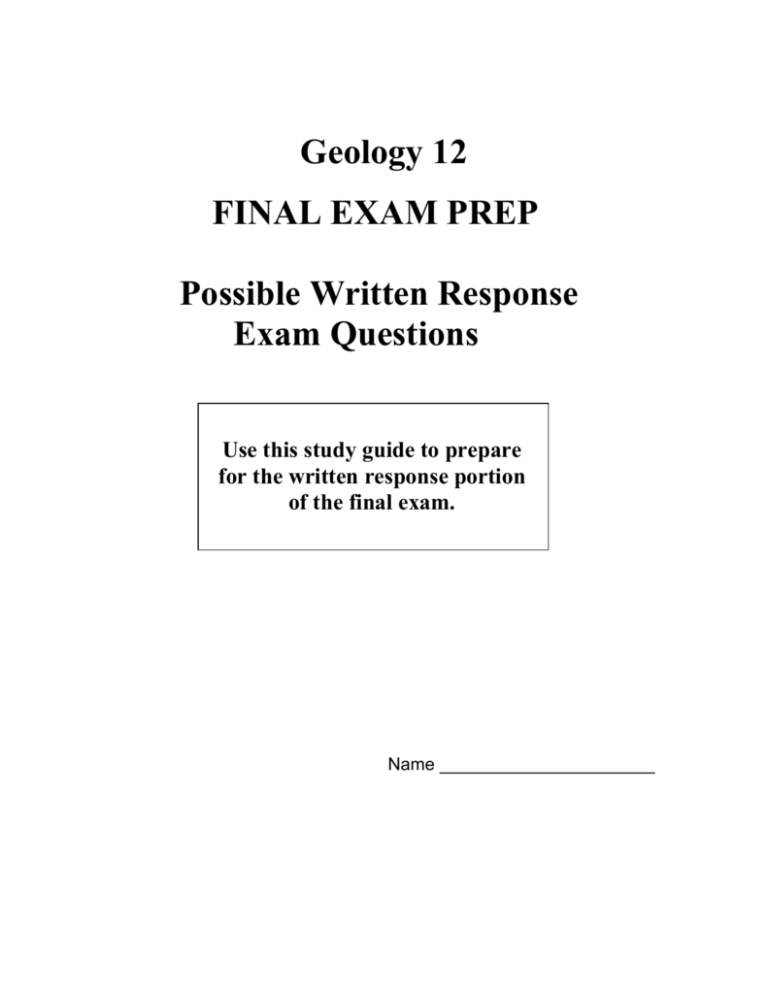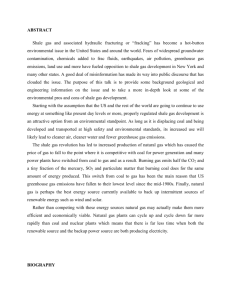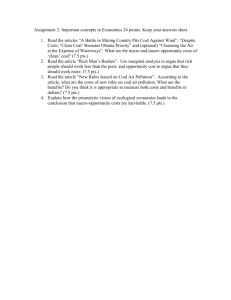Geology 12 FINAL EXAM PREP Possible Written Response Exam
advertisement

Geology 12 FINAL EXAM PREP Possible Written Response Exam Questions Use this study guide to prepare for the written response portion of the final exam. Name ______________________ FINAL EXAM - POSSIBLE WRITTEN RESPONSE QUESTIONS Use the following diagram of ripple marks and cross-bedding to answer question 1. west east 1. Describe how this structure might have formed. Include direction of flow in your answer. (2 marks) Use the following diagrams to answer question 2. August 2004 glacier 10 m August 2006 glacier 10 m 2. Helm Glacier on Mt. Garibaldi has been retreating since the summer of 2004, and leaving a recessional moraine every winter. On the August 2006 diagram above, draw and label (with date) recessional moraines that would likely have formed during the winters of 2004-2005 and 2005-2006. (2 marks) Use the diagram of a rotational slump to answer question 3. X edia omp M © Geoc 3. The slope shown above has become very unstable and is threatening a highway just below X. Describe two methods that would be used to stabilize the slope and safeguard the highway. (2 marks) Method 1: Method 2: Use the following graph which shows relationships between temperature, depth, and types of coal, to answer question 4. Temperature in degrees Celsius 25 50 75 100 125 150 175 200 225 0 Peat 1 Depth in kilometres 2 40–60% carbon Lignite coal 60–70% carbon 3 4 Bituminous coal 70–90% carbon 5 6 7 Anthracite coal (hard coal) 90–95% carbon 8 9 4. a) Describe a type of environment where a potential coal deposit could accumulate on the earth’s surface and the type of material that would accumulate to eventually become coal. (2 marks) b) According to the graph, at what temperature and depth would lignite change to bituminous coal? (1 mark) c) Choose one type of coal and describe a use for it. (1 mark) d) Why is anthracite (hard coal) often found in association with slate rather than shale or mudstone? (1 mark) 5. Complete the table below to show how the earth’s resources of coal and gravel are formed and used. (2 marks) Earth resource How it formed One use Example: Rock salt (halite) evaporation of sea water road salt Coal Gravel Use the following diagram of an oil and gas deposit to answer question 6 soil layer gas oil shale layer sandstone layer 10 m shale limestone layer 6. a) Describe how the oil and gas might have formed. (2 marks) b) Describe two characteristics of the rock materials that enable the oil and gas to accumulate in this particular location. (2 marks) Characteristic 1: Characteristic 2: Use the following description of a mineral to answer question 7. “A valuable mineral X forms mainly in hydrothermal veins, often associated with quartz and sulphide minerals. It is often found in placer deposits of unconsolidated sand, as well as sandstone and conglomerate. It may be confused with pyrite and chalcopyrite because of its similar appearance, but is easily distinguished on the basis of its higher density.” 7. a) i) What is mineral X? (1 mark) ii) Describe another test and its results that would distinguish mineral X from pyrite and chalcopyrite. (2 marks) Test Result for Mineral X b) Describe how a placer deposit forms. Result for Pyrite Result for Chalcopyrite (2 marks) c) Chalcopyrite is mined so that copper can be extracted from it. Describe one use of copper. (1 mark) For question 8, refer to the following in the Data Booklet. Properties of Common and Important Minerals REFERENCE DATA BOOKLET 8. Describe two properties that would help distinguish between chalcopyrite and pyrite. (2 marks) Property Description for chalcopyrite Description for pyrite Property 1: ______________________________ ______________________________ ______________________________ ______________________________ ______________________________ ______________________________ ______________________________ ______________________________ ______________________________ ______________________________ ______________________________ ______________________________ Property 2: 9. Name a resource found in British Columbia that has resulted from glacier or river processes. Give a specific use for that resource. (2 marks) Name of resource: Description of use: Use the following diagram of a submarine “black smoker” hydrothermal vent to answer question 10. Faults Hot, sulphide-rich water escapes Clams and tube worms Sea water Ocean floor Mineral ore body forms High heat flow Hot magma 10. a) New, large mineral deposits of copper, zinc, silver, etc. are forming today on the sea floor at the sites of hydrothermal vents. Referring to the diagram above, describe why the vents are usually located in an oceanic rift valley. (1 mark) b) Referring to the diagram above, describe a possible source for the metals in the hydrothermal solution. (1 mark) c) Explain why the ore minerals are often deposited close to the hydrothermal vent. (1 mark) Use the following graph which shows relationships between temperature, depth, and types of coal, to answer question 11. Temperature in degrees Celsius 25 50 75 100 125 150 175 200 225 0 Peat 1 Depth in kilometres 2 40–60% carbon Lignite coal 60–70% carbon 3 4 Bituminous coal 70–90% carbon 5 6 Anthracite coal 7 (hard coal) 90–95% carbon 8 9 11. a) Describe a type of environment where a potential coal deposit could accumulate on the earth’s surface and the type of material that would accumulate to eventually become coal. (2 marks) Type of environment: Type of material: b) According to the graph, at what temperature and depth would lignite change to bituminous coal? Temperature: c) Choose one type of coal and describe a use for it. (1 mark) Depth: (1 mark) d) Why is anthracite (hard coal) often found in association with slate rather than shale or mudstone? (1 mark) Use the following cross section diagrams of coal deposits to answer question 11e). Note the different scales of the cross sections. X Y coal seam 2m 100 m coal seam e) The two coal deposits X and Y were discovered in British Columbia, however neither of them will be mined at this time. i) Describe any geological or economic reason why deposit X will not be mined. (1 mark) ii) Describe a different geological or economic reason why deposit Y will not be mined. (1 mark) INSTRUCTIONS: Answer each question in the space provided. You may not need to use all of the space given. For question 12, refer to the diagram below and the following in the Data Booklet. Percentage of Minerals in Igneous Rocks REFERENCE DATA BOOKLET Siltstone Compaction and cementation High temperature and pressure Weathering and erosion to silt Formation of light and dark bands Rock X Rock Y Slow cooling inside the earth Melting Felsic/silicic magma 12. a) What type of rocks are rocks X and Y shown in the diagram above? Rock X: ______________________________________________ (1 mark) Rock Y: ______________________________________________ b) Describe a plate tectonic situation that would cause the high-grade metamorphism of the siltstone. (1 mark) INSTRUCTIONS: Answer each question in the space provided. You may not need to use all of the space given. Use the following partial, simplified, rock cycle diagram to answer question 13. PROCESS 3 Metamorphic Rock Magma PROCESS PROCESS 2 4 Sedimentary Rock Igneous Rock Example Process PROCESS 1 5 Sediment 13. Choose any two processes from the diagram above. For each process, describe the process and its probable plate tectonic location. An example is given. (4 marks) Process # Description of Process Example: Process 5 Igneous rocks in volcanic mountains are weathered and eroded to become sediments. Plate Tectonic Location Volcanic mountain range at converging plates. Use the following photograph of an igneous layer to answer question 14. X © GSC 14. Describe two pieces of evidence that could be found in or near the dark igneous layer at X to establish that it was a sill, and not a buried lava flow. (2 marks) Evidence 1: Evidence 2: Use the following block diagram of the southwest coast of BC to answer question 15. North American Plate Juan de Fuca Ridge Juan de Fuca Plate ade asc i-C ald s rib noe Ga olca v Pacific Plate 15. The subduction zone that lies under BC’s coast created the Garibaldi-Cascade volcanic chain. a) Why do these volcanoes lie parallel to the subduction zone? (1 mark) b) Describe one piece of evidence that could be found in or on the seafloor rocks that would indicate that seafloor spreading has occurred at the Juan de Fuca Ridge. (1 mark) Use the following geologic cross section to answer question 16. F S I M 5m (arranged in random order) Geologic event Cross section symbol Faulting F Igneous intrusion I Mafic intrusion M Deposition of sedimentary unit S 16. In the table below, place these geologic events in the order they occurred, with the oldest at the bottom and the youngest at the top. (2 marks) Youngest Oldest Use the following partial map and completed cross section of sedimentary rock layers to answer question 18. Geological Map pond 10 m black sandstone shale red sandstone siltstone Geological Cross Section 17. a) Using information from the cross section, complete the geological map. (2 marks) b) Place the correct strike and dip symbol in the box shown on the geological map. (1 mark) c) Place a Y on the youngest rock unit of the geological map. (1 mark) 18. A fossil-bearing shale is found between two old lava flows, as shown in the diagram below. Lava flow 1 Fossil-bearing shale Lava flow 2 Describe two general methods of determining the age of the fossil-bearing shale. (2 marks) Method 1: Method 2: 19. The Burgess Shale of Yoho National Park, B.C. is well known for the fine detail and the preservation of traces of soft parts in its fossils. List two factors that would lead to the occurrence of this type of preservation and for each explain how the factor promotes fossilization. (3 marks) Factor 1: Explanation: Factor 2: Explanation:






